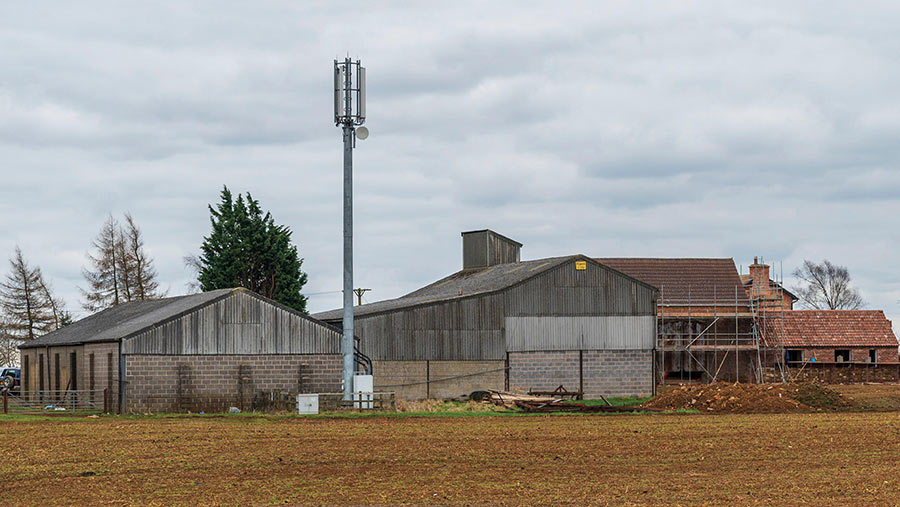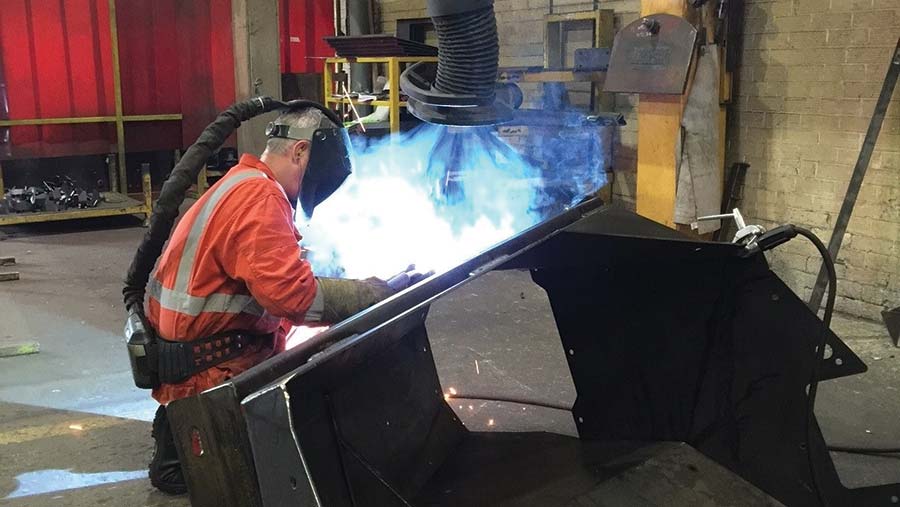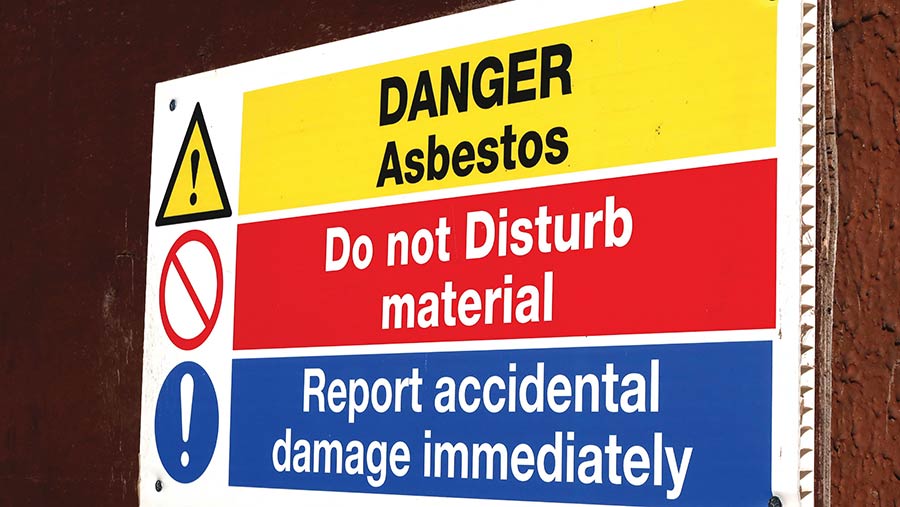How to manage less common farm health and safety risks
 © Matt Limb/Alamy Stock Photo
© Matt Limb/Alamy Stock Photo The fatal incident rate in agriculture over the past five years has on average been 21 times higher than that across all other industries.
Incidents involving animals or machinery and falls from height are largely responsible for the statistics, but there are other less common risks which, if not adequately controlled, can have a devastating impact on farmers, their workers and the business.
See also: Advice on farm staff issues with drug and alcohol use
Telecommunications equipment
Telecommunications masts are becoming more common on farms, despite downward pressure on rents.
Operators have compulsory access rights to land, which means landowners have very limited grounds to refuse to host a mast.
This equipment uses radio frequencies (RF) which can, with high levels of exposure, be a risk to human health.
Robin Whatley and Hayley Olley, of adviser Batcheller Monkhouse, say that when such equipment is located on rooftops, the telecoms operator should inform the site providers if there is a possibility that their employees and others within their control may come into close proximity to the antennas when working at roof level.
If this is likely, the landlord should request detailed plans of any required exclusion zones to understand where possible interactions arise.
There are also legislative requirements on the farm business, as the site provider, to keep people safe.
In the majority of cases, Hayley says, RF risk is not an issue as masts are located away from yards and at height.
However, if a mast is close to buildings or on the roof of a farm building, and it is possible that a worker may be working directly in front of the antennas, advice should be provided by the telecoms operator giving details of any exclusion areas which should not be entered.
This is typically a few metres in front of the antennas.
Farms employing more than five staff should include this guidance in their health and safety policy, says Hayley.
“If a farm has staff or contractors working in close proximity to, and particularly in front of, antennas, they need to make sure that they are aware of RF-related issues and should be checking before undertaking the work.”
Operators are obliged to put up signage where that interaction is possible.
Not all towers are operator-owned; sometimes they are landlord-owned and in this case the division of responsibility is less clear, says Robin.
The landlord may be liable for maintenance and repair of the mast, including annual inspection and certification, to ensure that health and safety obligations are met.
For anyone unsure of the position, he suggests seeking advice from the telecoms operator, the tenant or a specialist surveyor working in the telecoms market.
Gases and vapours

© Auto Extract Systems
Gases and vapours can be odourless and are often invisible to the naked eye, bringing the risk of their dangers being overlooked.
These could include welding fumes and slurry gases, says Robert Gazely, a partner at Ceres Rural.
Welding fumes have been reclassified by the Health and Safety Executive (HSE) as a potential carcinogen, so farmers must ensure that all welding equipment uses local exhaust ventilation or that respiratory protective equipment is used.
Atmospheres in grain bins and silos are hazardous, too, as the respiration of stored grain produces high levels of carbon dioxide.
Grain bins and silos could be classed as a confined space within the definition in the Confined Spaces Regulations 1997, says Robert.
Also, the Management of Health & Safety at Work Regulations 1999 require the employer to make a suitable and sufficient assessment of the health and safety risks employees are exposed to at work.
“In the case of silos and grain bins, consideration should be given to introducing a permit-to-work system and for tasks to be carried out with two persons, one of whom should be outside of the silo,” he recommends.
Venting of the structure and checking air quality with an oxygen meter, to prove a breathable atmosphere prior to entry, are advisable too, he adds.
Training relating to silo work should be provided to ensure employees have a clear understanding of the risks and required controls.
Interaction with diversified enterprises
Diversification enterprises come with their own health and safety implications which can be quite different to those of farming-only businesses.
Core agricultural and diversified enterprises should be adequately segregated on site, allowing vehicles and pedestrians to operate safely, says Robert, adding: “By law, pedestrians or vehicles must be able to use a traffic route without causing danger to the health or safety of people working near it.”
Roadways and footpaths should be separate whenever possible, and the business operator must consider protection for anyone working near vehicle routes.
“Traffic routes must also keep vehicles far enough away from doors or gates that pedestrians use, or from pedestrian routes that lead on to them, so the safety of pedestrians is not threatened,” Robert adds.
Pedestrians should be kept away from areas where vehicles are working, unless they need to be there.
He says a good example of this is designating areas for loading and unloading goods vehicles that are well away from pedestrian routes.
Where pedestrian and vehicle routes must cross, consider providing visually distinguished crossing points.
“If forklifts are involved, technology such as ‘blue dot’ warning lights can be helpful by alerting pedestrians when forklifts are reversing, particularly since operators often have restricted visibility and may inadvertently overlook people in the working area,” says Robert.
On-farm firearms

© Adobe Stock
If the farm diversification involves firearms, driven game or clay pigeon shooting, or if third parties are given permission to shoot vermin, the farmer or landowner should carry out a thorough risk assessment for workers, guns and beaters and ensure that they control and co-ordinate all use of firearms on the land.
Guns must have an appropriate licence for the weapon being used and valid public liability or third-party insurance too.
“If they are stalking deer, they should also hold appropriate certification,” says Robert.
The shoot should operate under the Code of Good Shooting Practice, produced by the British Association for Shooting and Conservation and other organisations.
The National Gamekeepers’ Organisation website also has comprehensive briefing sheets on risk assessment and health and safety.
It is important to ensure that guns do not obstruct, cause danger or alarm to users of the public highway, including on roads, bridleways and footpaths.
Section 161 of the Highways Act 1980 makes it an offence to discharge a firearm within 50ft of the centre of a highway where there are vehicular rights.
There may also be a liability in negligence if shooting constitutes a public nuisance or wilful obstruction.
If there are multiple guns, the use of firearms should be co-ordinated by making all shooters aware of the locations of other guns, and placing them at a safe distance from one another, Robert says.
Asbestos awareness

© Tony Smith/Alamy Stock Photo
Most farms will have some asbestos-containing materials, such as compressed asbestos-cement roof sheets, cladding, building partitions or rainwater gutters and downpipes.
The link between asbestos and cancer is well documented, so it is important that a farm employer takes steps to protect themselves and their workers from that danger.
The Control of Asbestos Regulations 2012 require farm owners and tenants to assess the presence and condition of any asbestos-containing materials.
The Health and Safety Executive (HSE) says that while it is not a legal requirement, a survey by a specialist company is recommended unless the business can be confident that no such materials are present on their premises.
Survey information can be used to assess the risks from asbestos and to decide what action needs to be taken to protect people’s health.
The survey and the action list will form an asbestos management plan.
Regular inspections will be required to keep the plan up to date, and appropriate steps taken to advise workers of the presence of asbestos, including farm employees.
The HSE suggests that well-sealed, undamaged asbestos is often best left alone, but it may be better to remove materials that are damaged.
If in doubt, expert help should be sought, it advises.
Tips for dealing with health and safety risks
- Telecoms masts Ask the site operator for exclusion zone plans and make staff aware of these.
- Welding fumes Use local exhaust ventilation or provide respiratory protective equipment.
- Grain bins and silos Consider a permit-to-work system and for tasks to be carried out with two persons, one of them outside the silo. Check venting and check air quality with an oxygen meter prior to entry.
- Diversified businesses Segregate core agricultural and alternative enterprises, separate roadways and footpaths whenever possible, consider protection for those working near vehicle routes and designating areas for loading and unloading goods vehicles well away from pedestrian routes.
- Shooting Carry out a thorough risk assessment for workers, guns, beaters and anyone else involved.
